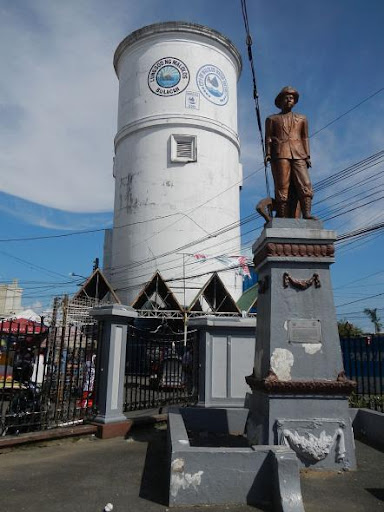Aguas Potables: Difference between revisions
No edit summary |
No edit summary |
||
| Line 3: | Line 3: | ||
Aguas Potables was established in the town in 1922. On March 28, 1923, construction was finished.<ref>.https://mb.com.ph/2021/09/10/historical-marker-of-98-year-old-aguas-potables-de-malolos-unveiled</ref> It is located in the center of Malolos' market city, next to the cathedral, and across from it is the statue of General Isidoro Torres, who became the alcalde mayor of Bulacan. He is also known as "Matanglawin," who founded numerous branches of the Katipunan.<ref>https://punto.com.ph/pananda-sa-98-taong-aguas-potables-ng-malolos-inilagak/</ref> The term "drinking water" originates from the Spanish "Aguas Potables." Another name for it is Aguas Potables de Malolos. A year later, the Consejo Municipal of Malolos renamed it "Mariano S. Tengco Water Works." in honor of the former mayor's public service. Aguas Potables is a cylinder-shaped, 80 feet (or 24.4 meters) high, or the height of a seven-story building.<ref>https://iorbitnews.com/pananda-sa-98-taong-aguas-potables-ng-malolos-inilagak/</ref> | |||
It became historical because it was constructed in the American era in order to meet the Maloleños' need for clean water—one aspect of the American Health and Hygiene System's era-improvement strategy. Because a running water system indicated the growing population and flow of prosperity in a town, it served as an icon during the time of the Americans. In our city of Malolos, the economy flourished alongside the increase in people.<ref>https://youtu.be/uFxmEq3pPwY?si=nATgpajX4pZhx3GZ</ref> | |||
In 2015, there was a plan to demolish Aguas Potables because it was slowly tilting and could be a danger to Maloleños. It was stopped by the National Museum of the Philippines and Maloleño groups to preserve it due to its approaching 100th anniversary. The one behind this campaign is Maloleño Raf Santillian, who launched a signature campaign under the Forum for Citizens Concerned of Malolos Network. According to Republic Act 10066, commonly known as the Natural Cultural Heritage Act of 2009, it is also eligible to be classified as an Important Cultural Property. <ref>https://youtu.be/uFxmEq3pPwY?si=nATgpajX4pZhx3GZ</ref> | |||
Revision as of 15:59, 13 November 2023
Article by Kim
Aguas Potables was established in the town in 1922. On March 28, 1923, construction was finished.[1] It is located in the center of Malolos' market city, next to the cathedral, and across from it is the statue of General Isidoro Torres, who became the alcalde mayor of Bulacan. He is also known as "Matanglawin," who founded numerous branches of the Katipunan.[2] The term "drinking water" originates from the Spanish "Aguas Potables." Another name for it is Aguas Potables de Malolos. A year later, the Consejo Municipal of Malolos renamed it "Mariano S. Tengco Water Works." in honor of the former mayor's public service. Aguas Potables is a cylinder-shaped, 80 feet (or 24.4 meters) high, or the height of a seven-story building.[3]
It became historical because it was constructed in the American era in order to meet the Maloleños' need for clean water—one aspect of the American Health and Hygiene System's era-improvement strategy. Because a running water system indicated the growing population and flow of prosperity in a town, it served as an icon during the time of the Americans. In our city of Malolos, the economy flourished alongside the increase in people.[4]
In 2015, there was a plan to demolish Aguas Potables because it was slowly tilting and could be a danger to Maloleños. It was stopped by the National Museum of the Philippines and Maloleño groups to preserve it due to its approaching 100th anniversary. The one behind this campaign is Maloleño Raf Santillian, who launched a signature campaign under the Forum for Citizens Concerned of Malolos Network. According to Republic Act 10066, commonly known as the Natural Cultural Heritage Act of 2009, it is also eligible to be classified as an Important Cultural Property. [5]
External Links:
- ↑ .https://mb.com.ph/2021/09/10/historical-marker-of-98-year-old-aguas-potables-de-malolos-unveiled
- ↑ https://punto.com.ph/pananda-sa-98-taong-aguas-potables-ng-malolos-inilagak/
- ↑ https://iorbitnews.com/pananda-sa-98-taong-aguas-potables-ng-malolos-inilagak/
- ↑ https://youtu.be/uFxmEq3pPwY?si=nATgpajX4pZhx3GZ
- ↑ https://youtu.be/uFxmEq3pPwY?si=nATgpajX4pZhx3GZ
